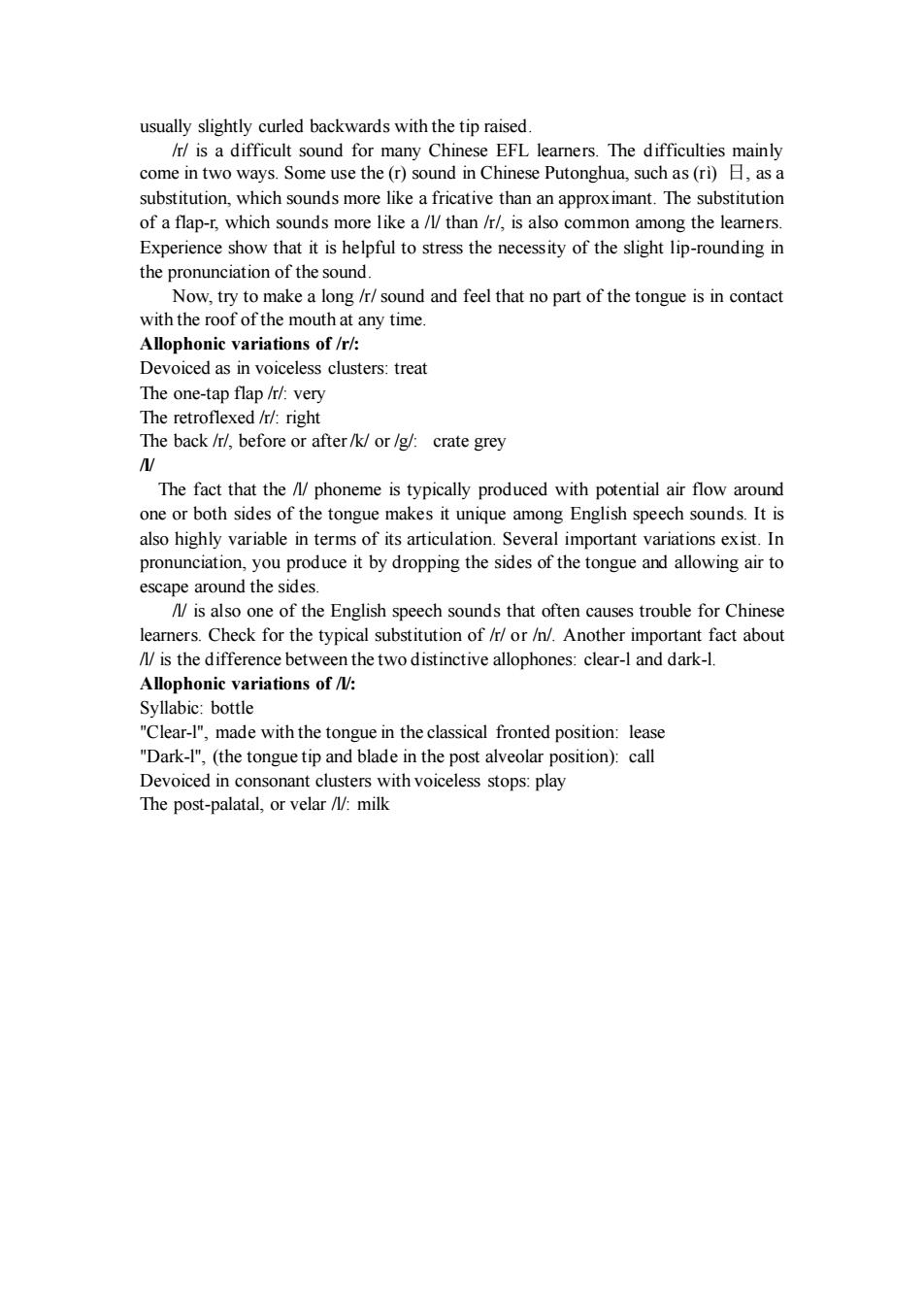正在加载图片...

usually slightly curled backwards with the tip raised. many Ch substitution,which sounds more like a fricative than an approx imant.The substitution of a flap-r,which sounds more like a/I/than/r/,is also common among the learners. Experience show that it is helpful to stress the necessity of the slight lip-rounding in ciation of the sound make a long/sound and feel that no part of the tongue is in contact with the roof of the mouth at any time. Allophonic variations of/r/: Devoiced as in voiceless clusters:treat The one-tap flap/very The retrofle righ The back//,before or after/k/or/g/:crate grey The fact that the /phoneme is typically produced with potential air flow around one or both sides of the tongue makes it unique among English speech sounds.It is veral important va exist.In tion,you produce it by dropping the sides of the tongue and allowing air to escape around the sides. n/is also one of the English speech sounds that often causes trouble for Chinese learners.Check for the typical substitution of/r/or /n/.Another important fact about /is the difference between the two distinctive allophones:clear-l and dark-1. Allophonic variations of /V: Syllabic:bottle "Clear-1",made with the tongue in the classical fronted position:lease "Dark-1"(the tongue tip and blade in the post alveolar position):call Devoiced in consonant clusters with voiceless stops:play The post-palatal,or velar milk usually slightly curled backwards with the tip raised. /r/ is a difficult sound for many Chinese EFL learners. The difficulties mainly come in two ways. Some use the (r) sound in Chinese Putonghua, such as (rì) 日, as a substitution, which sounds more like a fricative than an approximant. The substitution of a flap-r, which sounds more like a /l/ than /r/, is also common among the learners. Experience show that it is helpful to stress the necessity of the slight lip-rounding in the pronunciation of the sound. Now, try to make a long /r/ sound and feel that no part of the tongue is in contact with the roof of the mouth at any time. Allophonic variations of /r/: Devoiced as in voiceless clusters: treat The one-tap flap /r/: very The retroflexed /r/: right The back /r/, before or after /k/ or /g/: crate grey /l/ The fact that the /l/ phoneme is typically produced with potential air flow around one or both sides of the tongue makes it unique among English speech sounds. It is also highly variable in terms of its articulation. Several important variations exist. In pronunciation, you produce it by dropping the sides of the tongue and allowing air to escape around the sides. /l/ is also one of the English speech sounds that often causes trouble for Chinese learners. Check for the typical substitution of /r/ or /n/. Another important fact about /l/ is the difference between the two distinctive allophones: clear-l and dark-l. Allophonic variations of /l/: Syllabic: bottle "Clear-l", made with the tongue in the classical fronted position: lease "Dark-l", (the tongue tip and blade in the post alveolar position): call Devoiced in consonant clusters with voiceless stops: play The post-palatal, or velar /l/: milk